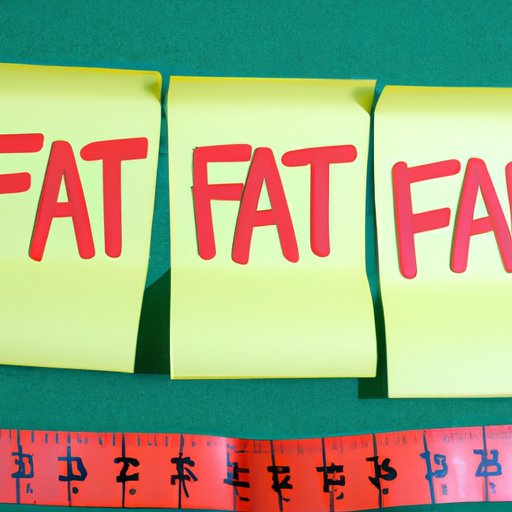The Ultimate Guide to Losing Belly Fat Fast: A Healthy and Sustainable Approach
The struggle to lose belly fat is a common issue for many people. It not only affects our appearance but also impacts our health. Belly fat, also known as visceral fat, can accumulate around vital organs, leading to health issues such as heart disease, type 2 diabetes, and high blood pressure. Losing belly fat can be challenging, but it is attainable with a healthy and sustainable lifestyle. In this article, we’ll explore different strategies for losing belly fat, ranging from exercise and diet to intermittent fasting and stress reduction.

The Science Behind Belly Fat: Understanding the Causes and Solutions
Belly fat can be divided into two types: subcutaneous fat, which is located underneath the skin, and visceral fat, which is located deep inside the abdominal cavity. Visceral fat is responsible for causing health problems and is more difficult to lose.
The causes of belly fat can vary, including genetics, age, and hormonal changes. Poor diet, lack of exercise, and high-stress levels can also contribute to the accumulation of belly fat. Losing belly fat is essential for improving health, reducing the risk of diseases, and boosting self-confidence.
Get Moving: The Benefits of Cardio and Weightlifting for Losing Belly Fat
One of the best ways to lose belly fat is through exercise. Cardiovascular exercise, such as walking, running, or cycling, increases heart rate and burns calories. Weightlifting builds muscle, which helps to increase metabolism and burn more fat. A combination of both types of exercise is ideal for losing belly fat.
Experts recommend 150 minutes of moderate-intensity cardio per week, in addition to strength-training workouts two to three times per week. It’s essential to find a type of exercise that you enjoy and incorporate it into your daily routine. Walking, taking the stairs, or cycling to work are simple ways to add more movement into your day.
A Healthy Diet for a Flat Tummy: Foods to Eat and Foods to Avoid
A healthy diet is crucial for losing belly fat. Processed foods, sugary drinks, and excessive alcohol intake can all contribute to belly fat. The best foods for burning belly fat are high in protein and fiber, such as lean meats, vegetables, and whole grains. Incorporating healthy fats, such as avocado and nuts, into your diet can also help to reduce belly fat.
Tracking food intake with a food diary or app can help to keep track of calorie intake and make healthier choices. Skip the fad diets or supplements and focus on long-term changes to your eating habits. It’s important to consult with a nutritionist or dietitian to create a personalized eating plan.
Adopting Intermittent Fasting: A Time-Tested Method for Fast Weight Loss
Intermittent fasting is a time-tested method for fast weight loss that involves restricting calorie intake during specific times. Intermittent fasting has several health benefits, including reduced inflammation and improved metabolism. Different types of intermittent fasting, including the 16/8 method and alternate-day fasting, can be customized to fit individual preferences and schedules.
It’s essential to ease into intermittent fasting and consult with a doctor or healthcare provider before starting. Fasting may not be appropriate for everyone, including pregnant women, breastfeeding mothers, and individuals with a history of disordered eating.
The Role of Stress Reduction in Losing Belly Fat: Easy Techniques to Try
Stress is a significant contributor to belly fat. When we experience stress, our bodies release cortisol, a hormone that encourages the accumulation of visceral fat. Finding ways to reduce stress can help to lower cortisol levels and reduce belly fat.
Techniques for stress reduction include meditation, yoga, deep breathing exercises, and getting enough sleep. Incorporating these techniques into your daily routine can provide significant benefits for both body and mind, including reduced stress levels and better sleep quality.
HIIT Workouts for a Toned Belly: How to Do Them and What to Expect
High-Intensity Interval Training (HIIT) is a type of exercise that involves short bursts of intense exercise followed by periods of rest. HIIT workouts have been shown to be effective for burning belly fat and building lean muscle. Examples of HIIT workouts include sprints, bodyweight exercises, and cycling.
It’s important to ease into HIIT workouts and consult with a healthcare provider before starting. HIIT may not be appropriate for individuals with health issues or those who are new to exercise. Slowly increasing the intensity and duration of HIIT workouts over time can help to avoid injury and improve results.
The Power of Sleep for Burning Belly Fat: Tips for Improving Your Sleep Habits
Getting enough sleep is essential for overall health, including losing belly fat. Lack of sleep can lead to an increase in cortisol, which contributes to belly fat. It’s essential to practice good sleep habits, such as avoiding screens before bedtime, keeping a consistent sleep schedule, and limiting caffeine intake.
Creating a relaxing bedtime routine and optimizing sleep conditions, such as using a comfortable mattress and keeping the bedroom cool and dark, can also help to improve the quality of sleep.
Conclusion
Losing belly fat can be challenging, but it’s attainable with a healthy and sustainable lifestyle. Combining exercise, a healthy diet, intermittent fasting, stress reduction, and good sleep habits can help to achieve a flat tummy and improve overall health. Remember to consult with a healthcare provider or a nutritionist before starting any new approach and take action to create a sustainable, healthy lifestyle.
